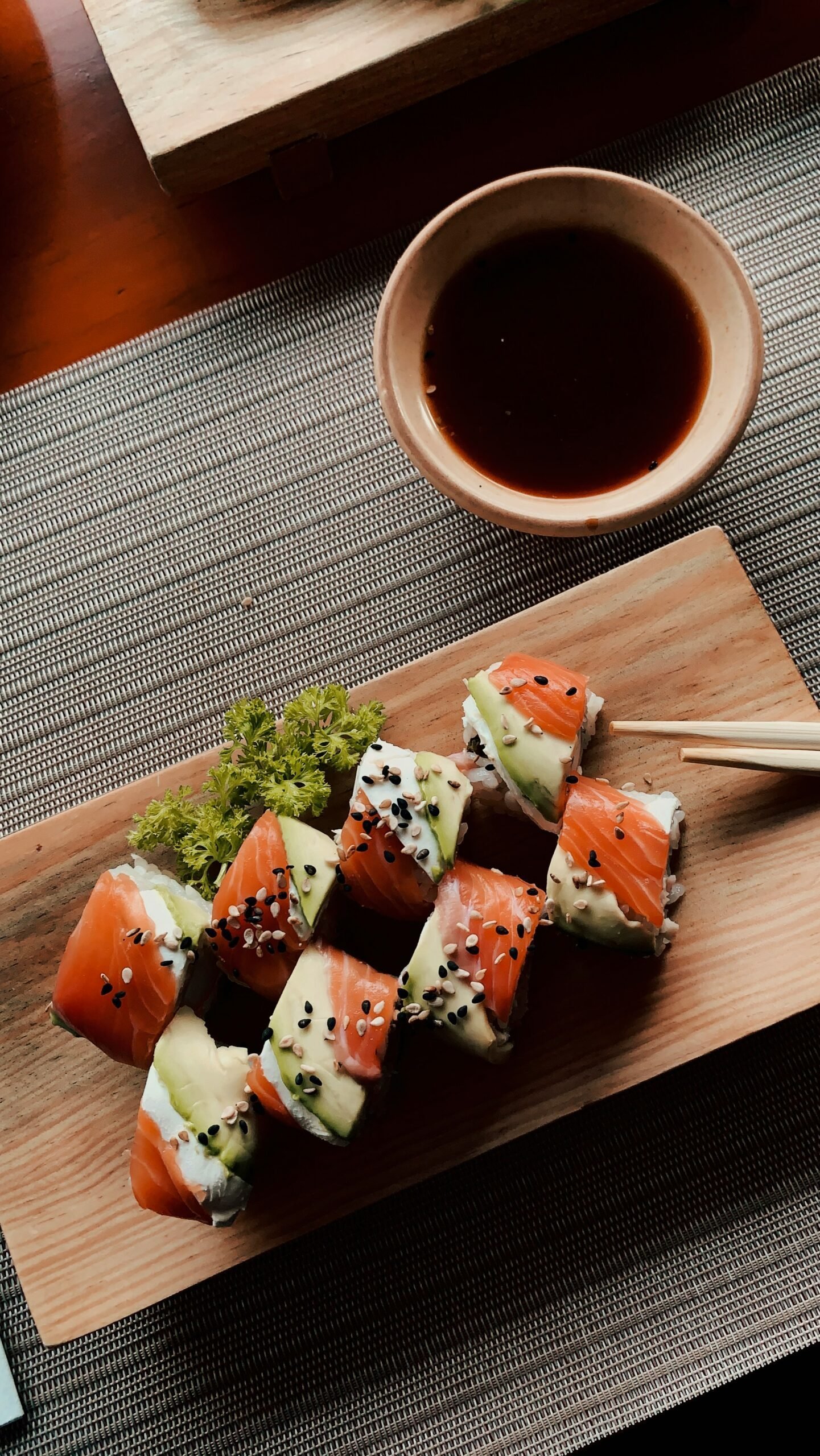
Introduction to All You Can Eat Sushi
All You Can Eat (AYCE) sushi has emerged as a beloved dining phenomenon, captivating sushi enthusiasts with the promise of unlimited access to a wide array of sushi delights. This unique dining experience allows patrons to indulge in an endless selection of sushi, sashimi, rolls, and other Japanese delicacies, all for a fixed price. The appeal of AYCE sushi lies not only in the quantity but also in the variety and freshness of the offerings.
The concept of AYCE sushi caters to the adventurous palate, encouraging diners to explore a diverse range of flavors and textures without the constraints of a traditional à la carte format. From classic favorites like tuna and salmon nigiri to innovative fusion rolls, the extensive menu options ensure that there is something for everyone. This dining model has seen a significant rise in popularity, particularly in urban areas where sushi culture thrives.
The appeal of AYCE sushi extends beyond the sheer volume of food. It offers a social and interactive dining experience, making it an attractive choice for groups and special occasions. The communal aspect of sharing plates and discovering new taste combinations together enhances the overall enjoyment. Additionally, the fixed pricing structure provides excellent value for money, allowing diners to savor high-quality sushi without worrying about escalating costs.
What sets AYCE sushi apart is the emphasis on freshness and quality. Many establishments take pride in sourcing fresh fish and ingredients daily, ensuring that each piece of sushi meets high culinary standards. This commitment to quality, coupled with the thrill of unlimited servings, makes AYCE sushi a compelling option for both seasoned sushi aficionados and newcomers alike.
In essence, AYCE sushi embodies the perfect blend of abundance, variety, and quality, making it a go-to choice for those looking to indulge in a comprehensive sushi experience. Whether it’s a casual meal or a celebratory feast, this dining trend continues to win the hearts of sushi lovers around the world.
The History and Evolution of Sushi
Sushi, a culinary delight that has captured the hearts and palates of food enthusiasts worldwide, boasts a rich and intricate history. Its origins can be traced back to ancient Japan, where it began as a method of preserving fish. In the 8th century, narezushi, or fermented fish wrapped in rice, emerged as an early precursor to modern sushi. This technique allowed fish to be stored for long periods, with the rice acting as a natural preservative.
By the Edo period (1603-1868), sushi had evolved into what is known today as nigirizushi. This transformation was largely attributed to Hanaya Yohei, who is credited with creating the hand-pressed sushi that became popular for its convenience and freshness. Nigirizushi featured slices of raw fish atop small mounds of vinegared rice, catering to the fast-paced lifestyle of Edo (now Tokyo) residents. This innovation marked a significant milestone in sushi’s history, setting the stage for its future global appeal.
As Japan opened up to the world during the Meiji Restoration in the late 19th century, sushi began to gain international recognition. Japanese immigrants brought their culinary traditions to various parts of the world, particularly the United States, where sushi bars started to appear in cities like Los Angeles and San Francisco in the mid-20th century. This period saw the birth of the California roll, an adaptation that utilized local ingredients like avocado and crab, making sushi more accessible to Western tastes.
The global popularity of sushi burgeoned in the late 20th and early 21st centuries, leading to the rise of all you can eat sushi restaurants. These establishments offer an endless array of sushi varieties, catering to diverse palates and preferences. The concept of all you can eat sushi has become a cultural phenomenon, allowing patrons to savor an unlimited assortment of rolls, sashimi, and nigiri, reflecting sushi’s ability to adapt and thrive in different cultural contexts.
Today, sushi continues to evolve, with chefs around the world experimenting with flavors, ingredients, and presentation. From traditional Japanese sushi to innovative fusion creations, the journey of sushi from ancient preservation method to all you can eat sushi buffets demonstrates its enduring appeal and versatility.
What to Expect at an All You Can Eat Sushi Restaurant
When you step into an all you can eat sushi restaurant, you’re embarking on a culinary adventure that promises an abundance of flavors and textures. These establishments are designed to provide a vast array of sushi options, catering to both traditionalists and those with a penchant for modern, creative rolls. Typically, you can expect a menu featuring classic favorites like nigiri, sashimi, and a variety of maki rolls, alongside innovative creations that incorporate diverse ingredients and culinary techniques.
The ordering process at all you can eat sushi restaurants is often streamlined to enhance your dining experience. Many places utilize a paper menu or an electronic tablet where you can mark your selections. This approach allows you to order multiple rounds of sushi at your leisure, ensuring that your meal is tailored to your preferences. It’s common for servers to gently remind patrons to order only what they can consume to minimize food waste, aligning with the restaurant’s sustainability practices.
The ambiance in these restaurants is usually designed to be welcoming and comfortable, with an emphasis on creating a relaxed environment. You might find minimalist décor, soothing lighting, and perhaps even traditional Japanese elements like tatami mats or bamboo accents. The atmosphere is conducive to both intimate dining experiences and larger gatherings, making it a versatile choice for various occasions.
There are a few guidelines and rules that customers should be aware of when dining at an all you can eat sushi restaurant. Most importantly, these establishments often have policies regarding leftovers. Many have a surcharge for uneaten food to discourage excessive ordering and waste. Additionally, there may be time limits for dining, particularly during peak hours, to ensure that all patrons have the opportunity to enjoy their meal without long waits. Being mindful of these guidelines helps ensure a pleasant experience for everyone.
Popular Sushi Rolls and Dishes to Try
When dining at an all you can eat sushi restaurant, the array of choices can be both exhilarating and overwhelming. Among the myriad of options, certain sushi rolls and dishes stand out as perennial favorites. One such classic is the California roll, which typically features imitation crab, avocado, and cucumber, all wrapped in a layer of seaweed and rice. This roll offers a delightful mix of textures and flavors, making it a perfect introduction for sushi novices.
For those seeking a bit more excitement, the spicy tuna roll is a popular option. Made with fresh tuna mixed with spicy mayo, this roll delivers a kick that is balanced by the coolness of cucumber and the creaminess of avocado. Another staple in any all you can eat sushi menu is sashimi. Unlike rolls, sashimi consists of thinly sliced raw fish served without rice. Common varieties include salmon, tuna, and yellowtail, each offering a pure and unadulterated taste of the ocean’s bounty.
Beyond these traditional favorites, many all you can eat sushi establishments offer unique and creative options that cater to more adventurous palates. The dragon roll, for instance, is a visually striking creation often made with eel, cucumber, and avocado, and topped with thin slices of avocado to resemble dragon scales. Another inventive dish is the tempura roll, which incorporates tempura-fried shrimp or vegetables, adding a satisfying crunch to each bite.
Some restaurants also feature specialty rolls that fuse sushi with other culinary traditions. For example, the Philadelphia roll combines smoked salmon, cream cheese, and cucumber, bringing a touch of American flavor to the sushi experience. Similarly, the rainbow roll offers a vibrant medley of sashimi atop a California roll base, creating a colorful and diverse flavor profile.
Whether you are a seasoned sushi aficionado or a curious beginner, the variety of rolls and dishes available at an all you can eat sushi restaurant ensures that there is something to satisfy every palate. From the familiar to the inventive, each bite promises a delightful journey through the rich and diverse world of sushi.
Tips for Getting the Most Out of Your Experience
Embarking on an all you can eat sushi adventure can be both exhilarating and overwhelming. To ensure you have a fulfilling experience, it’s crucial to adopt a few strategic approaches. First and foremost, pace yourself. Sushi, with its delicate balance of flavors and textures, is best savored slowly. Begin with lighter options such as sashimi and nigiri before progressing to more complex rolls. This not only allows you to appreciate the craftsmanship behind each piece but also helps avoid overeating too quickly.
Variety is the spice of life, and this holds especially true when it comes to an all you can eat sushi meal. Don’t hesitate to explore different sections of the menu. Sampling a range of dishes—from the classic California roll to more adventurous items like uni (sea urchin) or octopus—ensures you get a comprehensive taste experience. This diversity can also help balance your palate, making the entire meal more enjoyable.
Maximizing the value of your meal is another key aspect. All you can eat sushi offerings can be a great deal, but it’s essential to approach it wisely. Start with higher-value items such as sashimi, which often contains premium cuts of fish. However, remember that quality and enjoyment should trump quantity. Avoid the temptation to order massive amounts at once, as this can lead to waste and diminished dining pleasure.
Speaking of waste, it is imperative to be mindful of what you order. Most all you can eat sushi restaurants charge extra for uneaten food, so order in small batches to gauge your appetite accurately. This approach not only prevents waste but also allows you to stay attentive to your hunger cues, enhancing the overall experience.
In essence, enjoying an all you can eat sushi meal is an art. By pacing yourself, embracing variety, maximizing value, and being mindful of waste, you can indulge in the endless sushi delights responsibly and delightfully.
Health Benefits and Considerations
Sushi, a staple of Japanese cuisine, offers a multitude of health benefits that make it a popular choice among health-conscious diners. One of the primary advantages of sushi is its high protein content. Fish, the main ingredient in sushi, is an excellent source of lean protein, which is essential for muscle repair and growth. Additionally, protein helps to keep you feeling full longer, making sushi a satisfying and nutritious meal option.
Another significant benefit of indulging in all you can eat sushi is the abundance of omega-3 fatty acids found in many types of fish. Omega-3 fatty acids are known for their heart-healthy properties. They help reduce inflammation, lower blood pressure, and decrease the risk of heart disease. Fish such as salmon, mackerel, and tuna, commonly used in sushi, are particularly rich in these beneficial fats, contributing to overall cardiovascular health.
Sushi also provides a variety of vitamins and minerals. Seaweed, a common component in sushi rolls, is packed with essential nutrients like iodine, which supports thyroid function, as well as vitamins A, C, E, and K. Furthermore, the vegetables often included in sushi rolls, such as avocado, cucumber, and carrots, contribute additional vitamins, fiber, and antioxidants to the meal.
However, while the health benefits of sushi are numerous, there are also considerations to keep in mind. One such consideration is the mercury content found in certain fish, such as tuna and swordfish. High levels of mercury can be harmful, particularly for pregnant women and young children. It is advisable to limit consumption of these types of fish and choose lower-mercury options, such as salmon and shrimp, more frequently.
Additionally, moderation is key when enjoying all you can eat sushi. While the concept of endless sushi delights is appealing, it is important to be mindful of portion sizes and overall consumption. Overeating sushi can lead to excessive calorie intake, and some sushi rolls may contain high amounts of sodium, particularly those with soy sauce or other salty condiments.
In conclusion, sushi offers a myriad of health benefits, from high protein content and omega-3 fatty acids to essential vitamins and minerals. By being mindful of mercury levels and practicing moderation, you can enjoy the delicious and nutritious aspects of all you can eat sushi while maintaining a balanced diet.
Sustainable Sushi: What to Look For
As the popularity of all you can eat sushi continues to rise, it is crucial to consider the impact of our seafood choices on the environment. Sustainable sushi not only supports the health of our oceans but also ensures that future generations can enjoy these delicacies. When selecting sushi, there are several key factors to look for to ensure that your choices align with environmental conservation efforts.
Firstly, understanding the source of the seafood is paramount. Opt for sushi restaurants that prioritize responsibly sourced ingredients. This often involves selecting fish and other marine life that are abundant and caught or farmed in environmentally friendly ways. For instance, wild-caught fish from well-managed fisheries or aquaculture systems that do not harm surrounding ecosystems are preferable.
Certifications play a significant role in identifying sustainable sushi. Look for labels from reputable organizations such as the Marine Stewardship Council (MSC) or the Aquaculture Stewardship Council (ASC). These certifications indicate that the seafood has been harvested or farmed sustainably. Restaurants that display these certifications are typically committed to reducing their environmental footprint.
Moreover, be mindful of the types of fish being offered in all you can eat sushi menus. Certain species, such as bluefin tuna, are overfished and at risk of extinction. Instead, opt for alternatives like albacore tuna or skipjack tuna, which are more sustainable choices. Additionally, inquire about the fishing methods used; methods like pole-and-line or handline fishing are less likely to cause bycatch and habitat destruction compared to large-scale trawling or purse seining.
Lastly, consumer awareness and education are vital. By staying informed about sustainable seafood practices and supporting restaurants that prioritize responsible sourcing, we can collectively contribute to a healthier ocean ecosystem. Making mindful choices when indulging in all you can eat sushi not only enhances our dining experience but also plays a part in preserving the marine environment.
Conclusion: The Joy of Unlimited Sushi
The allure of ‘All You Can Eat’ sushi lies in its ability to offer an unparalleled dining experience. For sushi enthusiasts, it is a delightful opportunity to explore an extensive array of flavors, textures, and culinary artistry all in one sitting. The endless variety ensures that each bite is a new adventure, allowing diners to sample everything from traditional favorites like nigiri and sashimi to innovative rolls and unique chef specials.
This dining experience is more than just a meal; it is a journey through the intricate world of sushi craftsmanship. The format encourages diners to step out of their comfort zones, trying new dishes they might otherwise overlook. It is an invitation to appreciate the delicate balance of flavors and the meticulous preparation that goes into each piece of sushi.
Moreover, ‘All You Can Eat’ sushi brings a social aspect to dining, making it an ideal choice for gatherings with friends and family. Sharing a wide variety of sushi dishes fosters a communal atmosphere, enhancing the overall enjoyment of the meal. The excitement of unlimited sushi also means that there’s something for everyone, catering to both seasoned sushi aficionados and newcomers alike.
In conclusion, the joy of unlimited sushi is a unique experience that combines culinary exploration with the pleasure of indulgence. It offers a rare chance to savor a multitude of sushi creations in one sitting, making it a must-try for anyone looking to expand their palate and enjoy a memorable dining adventure. So, the next time you crave sushi, consider the ‘All You Can Eat’ option and immerse yourself in the endless sushi delights it has to offer.



